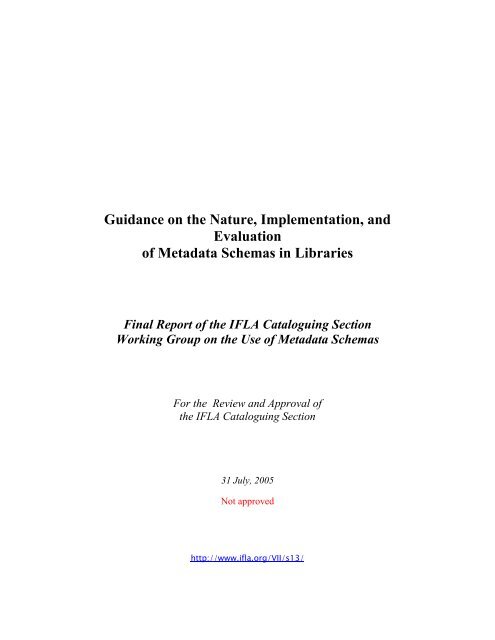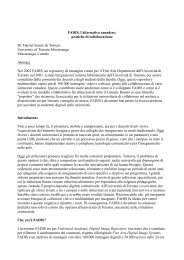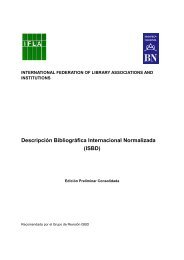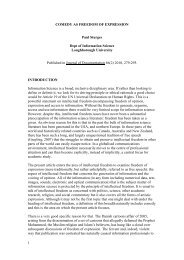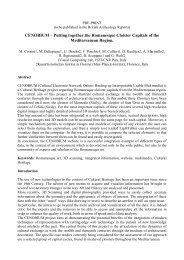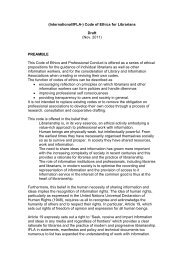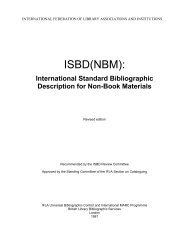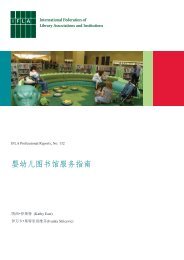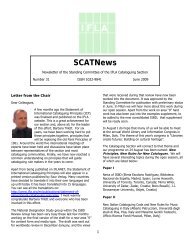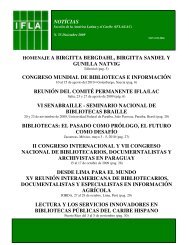Guidance on the Nature, Implementation, and Evaluation of ... - IFLA
Guidance on the Nature, Implementation, and Evaluation of ... - IFLA
Guidance on the Nature, Implementation, and Evaluation of ... - IFLA
You also want an ePaper? Increase the reach of your titles
YUMPU automatically turns print PDFs into web optimized ePapers that Google loves.
<str<strong>on</strong>g>Guidance</str<strong>on</strong>g> <strong>on</strong> <strong>the</strong> <strong>Nature</strong>, Implementati<strong>on</strong>, <strong>and</strong><br />
Evaluati<strong>on</strong><br />
<strong>of</strong> Metadata Schemas in Libraries<br />
Final Report <strong>of</strong> <strong>the</strong> <strong>IFLA</strong> Cataloguing Secti<strong>on</strong><br />
Working Group <strong>on</strong> <strong>the</strong> Use <strong>of</strong> Metadata Schemas<br />
For <strong>the</strong> Review <strong>and</strong> Approval <strong>of</strong><br />
<strong>the</strong> <strong>IFLA</strong> Cataloguing Secti<strong>on</strong><br />
31 July, 2005<br />
Not approved<br />
http://www.ifla.org/VII/s13/
<str<strong>on</strong>g>Guidance</str<strong>on</strong>g> <strong>on</strong> <strong>the</strong> <strong>Nature</strong>, Implementati<strong>on</strong>, <strong>and</strong> Evaluati<strong>on</strong><br />
<strong>of</strong> Metadata Schemas in Libraries<br />
Secti<strong>on</strong><br />
Final Report <strong>of</strong> <strong>the</strong> <strong>IFLA</strong> Cataloguing Secti<strong>on</strong><br />
Working Group <strong>on</strong> <strong>the</strong> Use <strong>of</strong> Metadata Schemas<br />
For <strong>the</strong> Review <strong>and</strong> Approval <strong>of</strong><br />
<strong>the</strong> <strong>IFLA</strong> Cataloguing Secti<strong>on</strong><br />
31 July, 2005<br />
1.0 Introducti<strong>on</strong><br />
1.1 Background to <strong>the</strong> report<br />
1.2 Working Group’s terms <strong>of</strong> reference<br />
1.3 Working Group membership<br />
1.4 Working Group activities <strong>and</strong> accomplishments<br />
2.0 Using Metadata in Libraries or O<strong>the</strong>r Informati<strong>on</strong>-Intensive Organizati<strong>on</strong>s<br />
2.1 Initiating a Metadata Project<br />
2.2 Selecting a Metadata Schema or Schemas<br />
2.3 Suggested Specific Uses for Metadata Records<br />
2.4 Some Core Attributes in Metadata Schemas<br />
Selected Bibliography <strong>of</strong> Metadata Resources<br />
Appendices:<br />
I. Core attributes <strong>and</strong> <strong>the</strong>ir presence in selected metadata schemas<br />
II. Core attributes in metadata schemas – by frequency <strong>of</strong> occurrence<br />
Working Group <strong>on</strong> <strong>the</strong> Use <strong>of</strong> Metadata Schemas: Final Report – July 31, 2005 Page 2 <strong>of</strong> 22
<str<strong>on</strong>g>Guidance</str<strong>on</strong>g> <strong>on</strong> <strong>the</strong> <strong>Nature</strong>, Implementati<strong>on</strong>, <strong>and</strong> Evaluati<strong>on</strong><br />
<strong>of</strong> Metadata Schemas in Libraries<br />
1.0 INTRODUCTION<br />
Final Report <strong>of</strong> <strong>the</strong> <strong>IFLA</strong> Cataloguing Secti<strong>on</strong><br />
Working Group <strong>on</strong> <strong>the</strong> Use <strong>of</strong> Metadata Schemas<br />
1.1 Background to <strong>the</strong> final report<br />
Over <strong>the</strong> past decade, <strong>the</strong> proliferati<strong>on</strong> <strong>of</strong> electr<strong>on</strong>ic texts, images, sounds, <strong>and</strong><br />
objects stored in Internet- <strong>and</strong> Intranet-accessible knowledge bases or o<strong>the</strong>r digital<br />
repositories has increased <strong>the</strong> potential range <strong>and</strong> quantity <strong>of</strong> readily-accessible<br />
multimedia informati<strong>on</strong>. It has also resulted in what Levy (1990) 1 has referred to as a<br />
“sec<strong>on</strong>d flood”, threatening to drown <strong>the</strong> engaged searcher in massive amounts <strong>of</strong><br />
material, both useful <strong>and</strong> irrelevant. The need to delimit electr<strong>on</strong>ic resources more<br />
precisely in order to facilitate access has intensified activity in <strong>the</strong> development <strong>of</strong><br />
metadata schemas – with metadata generally defined as “data about data”. This<br />
“Metadata Movement”, as Baker 2 has described it, has included <strong>the</strong> development <strong>of</strong><br />
general applicati<strong>on</strong> metadata schemas, such as <strong>the</strong> Dublin Core (DC), <strong>the</strong> Government<br />
Informati<strong>on</strong> Locator Service [now Global Informati<strong>on</strong> Locator Service] (GILS), or<br />
Digital Object Identifier (DOI), as well as domain-specific metadata schemas, such as <strong>the</strong><br />
Text Encoding Initiative (TEI), <strong>the</strong> Encoded Archival Descripti<strong>on</strong> (EAD), <strong>the</strong> Visual<br />
Resources Associati<strong>on</strong> (VRA) Core Categories, <strong>the</strong> C<strong>on</strong>tent St<strong>and</strong>ard for Digital<br />
Geospatial Metadata (CSDGM), <strong>and</strong> <strong>the</strong> Online Informati<strong>on</strong> Exchange (ONIX)<br />
publishing st<strong>and</strong>ard – to name <strong>on</strong>ly a few. Such schemas are based <strong>on</strong> a comm<strong>on</strong><br />
“machine-readable” syntax, such as HTML (Hypertext Markup Language), SGML<br />
(St<strong>and</strong>ard Generalized Markup Language), or XML (eXtensible Markup Language).<br />
Metadata-enabled search engines can thus retrieve by precise metatags <strong>and</strong> values, those<br />
electr<strong>on</strong>ic resources in which a metadata record is embedded, or to which a separately<br />
housed metadata record points.<br />
1.2 Working Group’s terms <strong>of</strong> reference<br />
In resp<strong>on</strong>se to a growing internati<strong>on</strong>al interest in, <strong>and</strong> applicati<strong>on</strong> <strong>of</strong>, metadata<br />
schemas 3 <strong>the</strong> <strong>IFLA</strong> Cataloguing Secti<strong>on</strong> Working Group <strong>on</strong> <strong>the</strong> Use <strong>of</strong> Metadata<br />
Schemas was established at <strong>the</strong> <strong>IFLA</strong> 1998 C<strong>on</strong>ference in Amsterdam, <strong>the</strong> Ne<strong>the</strong>rl<strong>and</strong>s.<br />
1 Levy, Pierre. 1990. Les Technologies de l’Intelligence. Paris: La Découverte.<br />
2 Baker, Thomas. 1999. Organizing Access with Metadata.TIAC White Paper <strong>on</strong> Appropriate<br />
Technology for Digital Libraries at URL: http://www.tiac.or.th/tiacweb/Baker/Secti<strong>on</strong>2_3.html.<br />
Accessed 31-07-02<br />
3 For a definiti<strong>on</strong> <strong>of</strong> <strong>the</strong> term, “schemas”, see URL: http://www.linkti<strong>on</strong>ary.com/s/schema.html<br />
Working Group <strong>on</strong> <strong>the</strong> Use <strong>of</strong> Metadata Schemas: Final Report – July 31, 2005 Page 3 <strong>of</strong> 22
The Working Group drafted its terms <strong>of</strong> reference agreeing to focus <strong>on</strong> outcomes<br />
deriving from <strong>the</strong> following three objectives:<br />
• Objective 1: to create an inventory <strong>of</strong> <strong>the</strong> development <strong>and</strong><br />
implementati<strong>on</strong>/applicati<strong>on</strong> <strong>of</strong> metadata schemas in different countries<br />
• Objective 2: to provide guidance (<strong>and</strong> ultimately, as appropriate, guidelines) to<br />
libraries as to when <strong>and</strong>/or how best to use metadata records <strong>and</strong> bibliographic<br />
records (catalogue records)<br />
• Objective 3: to determine a metadata “core record” – i.e., a set <strong>of</strong> most comm<strong>on</strong>ly<br />
occurring elements in selected metadata schemas – that could be used by authors<br />
<strong>and</strong>/or publishers <strong>of</strong> electr<strong>on</strong>ic records to enhance resource discovery, <strong>and</strong> to<br />
provide, where appropriate, elements for incorporati<strong>on</strong> into bibliographic records<br />
(catalogue records)<br />
1.3 Working Group membership<br />
While not all members listed below have been active throughout <strong>the</strong> full 1998-2005<br />
period, Working Group membership has included <strong>the</strong> following:<br />
• Fern<strong>and</strong>a Campos, Portugal<br />
• Lois Mai Chan, USA<br />
• Assumpcio Estivill, Spain<br />
• Christel Hengel, Germany<br />
• Lynne C. Howarth, Canada (Chair)<br />
• M<strong>on</strong>a Madsen, Denmark (to 2001)<br />
• Dorothy McGarry, USA<br />
• M<strong>on</strong>ika Muennich, Germany<br />
• Eeva Murtomaa, Finl<strong>and</strong><br />
• Glenn Patt<strong>on</strong>, USA<br />
• Charlotte Peders<strong>on</strong>, Denmark (2001-)<br />
• Barbara Tillett, USA<br />
• Mirna Willer, Croatia<br />
• Maria Witt, France<br />
• Maja Žumer, Slovenia<br />
In additi<strong>on</strong>, <strong>the</strong> Working Group has invited input – <strong>and</strong>, in some cases, representati<strong>on</strong> –<br />
from <strong>the</strong> <strong>IFLA</strong> Secti<strong>on</strong>s <strong>on</strong> Informati<strong>on</strong> Technology, Classificati<strong>on</strong> <strong>and</strong> Indexing,<br />
Bibliography, <strong>and</strong> Libraries for <strong>the</strong> Blind, as well as from <strong>the</strong> Permanent UNIMARC<br />
Committee (PUC) <strong>and</strong> <strong>the</strong> DCMI Libraries Working Group.<br />
1.4 Working Group activities <strong>and</strong> accomplishments<br />
In fulfilling its terms <strong>of</strong> reference, <strong>the</strong> Working Group held six sets <strong>of</strong> formal meetings,<br />
beginning in Bangkok, Thail<strong>and</strong> at <strong>the</strong> <strong>IFLA</strong> 1999 C<strong>on</strong>ference, <strong>and</strong> c<strong>on</strong>tinuing at<br />
subsequent annual sessi<strong>on</strong>s <strong>of</strong> <strong>the</strong> <strong>IFLA</strong> World Library <strong>and</strong> Informati<strong>on</strong> C<strong>on</strong>gress<br />
(WLIC) in Jerusalem, Israel (2000), Bost<strong>on</strong>, USA (2001), Glasgow, Scotl<strong>and</strong> (2002),<br />
Berlin, Germany (2003), <strong>and</strong> Buenos Aires, Argentina (2004). Over <strong>the</strong> six-year period,<br />
Working Group <strong>on</strong> <strong>the</strong> Use <strong>of</strong> Metadata Schemas: Final Report – July 31, 2005 Page 4 <strong>of</strong> 22
<strong>the</strong> Working Group c<strong>on</strong>centrated <strong>on</strong> completing its three objectives (see secti<strong>on</strong> 1.2,<br />
above). Corresp<strong>on</strong>dingly, <strong>and</strong> in partnership with <strong>the</strong> <strong>IFLA</strong> Informati<strong>on</strong> Technology<br />
Secti<strong>on</strong> (ITS), <strong>the</strong> Working Group presented a program at <strong>the</strong> <strong>IFLA</strong> 2000 c<strong>on</strong>ference in<br />
Jerusalem, Israel, showcasing a number <strong>of</strong> innovative metadata projects. It also cosp<strong>on</strong>sored<br />
(with ITS) <strong>the</strong> Metadata Discussi<strong>on</strong> Group (at <strong>IFLA</strong> c<strong>on</strong>ferences in 2000,<br />
2001, <strong>and</strong> 2002), <strong>and</strong> engaged in discussi<strong>on</strong>s with <strong>the</strong> DCMI Libraries Working Group.<br />
These various efforts culminated in a draft report, <str<strong>on</strong>g>Guidance</str<strong>on</strong>g> <strong>on</strong> <strong>the</strong> Structure, C<strong>on</strong>tent,<br />
<strong>and</strong> Applicati<strong>on</strong> <strong>of</strong> Metadata Records for Digital Resources <strong>and</strong> Collecti<strong>on</strong>s, that was<br />
posted <strong>on</strong> <strong>IFLA</strong>NET for worldwide review from mid-November 2003 to mid-February<br />
2004. A paper 4 summarizing comments from <strong>the</strong> review, <strong>and</strong> outlining next-steps for <strong>the</strong><br />
Working Group was presented as part <strong>of</strong> <strong>the</strong> <strong>IFLA</strong> Cataloguing Secti<strong>on</strong> program at WLIC<br />
2004 in Buenos Aires, Argentina. Feedback both from <strong>the</strong> worldwide review, <strong>and</strong> from<br />
meetings at WLIC 2004 <strong>of</strong> <strong>the</strong> <strong>IFLA</strong> Cataloguing Secti<strong>on</strong> <strong>and</strong> <strong>the</strong> Working Group,<br />
respectively, were incorporated into this final report.<br />
1.5 Scope <strong>and</strong> outline <strong>of</strong> <strong>the</strong> final report<br />
Comments deriving from <strong>the</strong> worldwide review <strong>and</strong> from WLIC 2004 meetings<br />
c<strong>on</strong>firmed three clear directi<strong>on</strong>s for <strong>the</strong> Working Group to pursue in completing both its<br />
final report <strong>and</strong> its m<strong>and</strong>ate. First was <strong>the</strong> acknowledgement that, with <strong>the</strong> obvious<br />
intensifying <strong>of</strong> metadata-focused activity, <strong>the</strong> initial objective <strong>of</strong> creating an inventory <strong>of</strong><br />
implementati<strong>on</strong>s was no l<strong>on</strong>ger feasible. Moreover, it was felt that, with <strong>the</strong> emergence<br />
<strong>of</strong> metadata registries for identifying <strong>and</strong> tracking implementati<strong>on</strong>s <strong>and</strong> adaptati<strong>on</strong>s <strong>of</strong><br />
different metadata schemas, <strong>the</strong>re were formal <strong>and</strong> well-maintained sources for <strong>the</strong><br />
internati<strong>on</strong>al bibliographic community to access. The metadata site accessible via<br />
<strong>IFLA</strong>NET (http://www.ifla.org/II/metadata.htm) provides an excellent starting point for<br />
those interested in examples <strong>of</strong> project implementati<strong>on</strong>s. Likewise, <strong>the</strong> Dublin Core<br />
Metadata Initiative (DCMI) site (http://dublincore.org/) maintains applicati<strong>on</strong> pr<strong>of</strong>iles for<br />
different Dublin Core implementer domains (e.g., libraries; educati<strong>on</strong>; government), as<br />
well as a DCMI Registry. O<strong>the</strong>r metadata schemas maintain Web-accessible sites with<br />
regularly updated schema documentati<strong>on</strong>, project registries, links to o<strong>the</strong>r implementers,<br />
<strong>and</strong> helpful c<strong>on</strong>tacts. Such resources should be accessed directly by those c<strong>on</strong>templating<br />
or already engaged in a metadata project implementati<strong>on</strong>.<br />
The sec<strong>on</strong>d clear directi<strong>on</strong> to <strong>the</strong> Working Group involved restating Objective 2<br />
to read: “To provide guidance to <strong>the</strong> library community <strong>on</strong> <strong>the</strong> nature <strong>and</strong><br />
implementati<strong>on</strong> <strong>of</strong> metadata schemes, including bibliographic or catalogue records, so<br />
that a project can evaluate <strong>and</strong> select which scheme will best match <strong>the</strong> goals <strong>of</strong> <strong>the</strong><br />
project.” With this restatement in mind, <strong>and</strong> building <strong>on</strong> secti<strong>on</strong> 2 <strong>of</strong> <strong>the</strong> draft report, <strong>the</strong><br />
Working Group has summarized a number <strong>of</strong> high level c<strong>on</strong>siderati<strong>on</strong>s which should<br />
provide initial guidance to libraries undertaking a metadata project. Secti<strong>on</strong> 2.0 Using<br />
4 Howarth, Lynne C. Enabling Metadata: Creating Core Records for Resource Discovery.<br />
World Library <strong>and</strong> Informati<strong>on</strong> C<strong>on</strong>gress: 70 th <strong>IFLA</strong> General C<strong>on</strong>ference <strong>and</strong> Council, August<br />
22-27, 2004, Buenos Aires, Argentina. Accessible at: http://www.ifla.org/IV/ifla70/papers/008e-<br />
Howarth.pdf<br />
Working Group <strong>on</strong> <strong>the</strong> Use <strong>of</strong> Metadata Schemas: Final Report – July 31, 2005 Page 5 <strong>of</strong> 22
Metadata in Libraries or O<strong>the</strong>r Informati<strong>on</strong>-Intensive Organizati<strong>on</strong>s, outlines key points<br />
regarding how to initiating a metadata project, how to select <strong>and</strong> evaluate a metadata<br />
schema or schemas, <strong>and</strong> what elements to c<strong>on</strong>sider as important or essential to a metadata<br />
record, particularly where records may be shared with o<strong>the</strong>r repositories.<br />
The third directive to <strong>the</strong> Working Group was that <strong>of</strong> rethinking <strong>and</strong> recasting<br />
totally <strong>the</strong> third objective. The purpose <strong>of</strong> <strong>the</strong> proposed “core <strong>of</strong> cores” that appeared in<br />
secti<strong>on</strong> 3 <strong>of</strong> <strong>the</strong> draft report was c<strong>on</strong>fusing <strong>and</strong> unclear to most reviewers. While <strong>on</strong>e<br />
nati<strong>on</strong>al cataloguing committee endorsed <strong>the</strong> c<strong>on</strong>cept <strong>of</strong> <strong>the</strong> “core <strong>of</strong> cores”, “ … as a<br />
framework with <strong>the</strong> potential to bring about a comm<strong>on</strong>, minimal st<strong>and</strong>ard <strong>and</strong> extended<br />
interoperability between metadata produced in different projects <strong>and</strong> by different agents,”<br />
o<strong>the</strong>rs found its articulati<strong>on</strong> as a “core record framework” misleading <strong>and</strong> largely<br />
reflective <strong>of</strong> <strong>the</strong> Dublin Core element set. The Working Group elected to recast<br />
Objective 3 as suggested by <strong>on</strong>e <strong>of</strong> <strong>the</strong> nati<strong>on</strong>al cataloguing committees that participated<br />
in <strong>the</strong> worldwide review. As <strong>the</strong> latter noted, “Since librarians are already active<br />
participants in <strong>the</strong> <strong>on</strong>going development <strong>of</strong> many <strong>of</strong> <strong>the</strong> metadata schemas noted in this<br />
secti<strong>on</strong>, <strong>the</strong> best way to accomplish <strong>the</strong> aims <strong>of</strong> Objective 3 would be through <strong>the</strong><br />
development <strong>of</strong> a “library applicati<strong>on</strong> pr<strong>of</strong>ile” 5 specific to any metadata schema that a<br />
library might choose to employ, ra<strong>the</strong>r than a general across-<strong>the</strong>-board set <strong>of</strong> elements<br />
meant to apply to any metadata schema.” In a similar vein, ano<strong>the</strong>r nati<strong>on</strong>al agency<br />
<strong>of</strong>fered <strong>the</strong> following:<br />
There is some c<strong>on</strong>fusi<strong>on</strong> as to what was intended for <strong>the</strong> “core <strong>of</strong><br />
cores”—it seems that it was starting out to describe a core set <strong>of</strong><br />
elements that should be part <strong>of</strong> any metadata schema that was<br />
designed (a good idea); but, it sometimes implies that <strong>the</strong>se are core<br />
data elements that should be in every metadata record (i.e., every<br />
metadata record should have something from each <strong>of</strong> <strong>the</strong>se core<br />
elements)—this would be problematic in that not all elements would<br />
be appropriate for every record. We suggest <strong>the</strong> emphasis should be<br />
more clearly placed <strong>on</strong> core elements that should be a part <strong>of</strong> all<br />
metadata schemas, <strong>and</strong> remove references to a core “record” per se.<br />
Thus, <strong>the</strong> Working Group has elected to include its ten “core” elements within <strong>the</strong> secti<strong>on</strong><br />
in this final report that deals with how to select <strong>and</strong> evaluate a metadata schema or<br />
schemas.<br />
2.0 USING METADATA IN LIBRARIES OR OTHER INFORMATION-<br />
INTENSIVE ORGANIZATIONS<br />
The following secti<strong>on</strong> <strong>of</strong>fers some high level guidance to individuals <strong>and</strong>/or<br />
libraries c<strong>on</strong>templating a metadata project. Included are suggesti<strong>on</strong>s c<strong>on</strong>cerning how to<br />
approach a metadata project, <strong>the</strong> types <strong>of</strong> metadata that may be required to support <strong>the</strong><br />
project, <strong>and</strong> whe<strong>the</strong>r or when to use an existing schema or institute a local metadata<br />
schema. The secti<strong>on</strong> c<strong>on</strong>cludes with some recommendati<strong>on</strong>s c<strong>on</strong>cerning <strong>the</strong> most<br />
5 This terminology comes from <strong>the</strong> Dublin Core Metadata Initiative, where such a pr<strong>of</strong>ile has been<br />
developed.<br />
Working Group <strong>on</strong> <strong>the</strong> Use <strong>of</strong> Metadata Schemas: Final Report – July 31, 2005 Page 6 <strong>of</strong> 22
appropriate use <strong>of</strong> metadata records uniquely, or in c<strong>on</strong>cert with, bibliographic records –<br />
as a potential c<strong>on</strong>text or guidance to libraries planning to incorporate metadata in some<br />
part <strong>of</strong> <strong>the</strong>ir bibliographic activities.<br />
2.1 Initiating a Metadata Project<br />
• Defining <strong>the</strong> Scope, Inclusi<strong>on</strong> Criteria, <strong>and</strong> Purpose <strong>of</strong> <strong>the</strong> Project<br />
Prior to initiating a metadata project, it will be important for <strong>the</strong> library or bibliographic<br />
agency to define clearly <strong>the</strong> nature, scope, coverage, inclusi<strong>on</strong>/exclusi<strong>on</strong> criteria for<br />
selecti<strong>on</strong>, <strong>and</strong> format(s) <strong>of</strong> items or objects to be included in <strong>the</strong> “digital collecti<strong>on</strong>”<br />
(portal, subject gateway, knowledge repository, etc.) for which metadata records will be<br />
created. For what kinds <strong>of</strong> electr<strong>on</strong>ic resources will identificati<strong>on</strong> <strong>and</strong> access (links) be<br />
required?<br />
• General Metadata Record Types or Structures<br />
Depending <strong>on</strong> what is included, <strong>and</strong> <strong>the</strong> intended purpose(s) or use <strong>of</strong> <strong>the</strong> library’s<br />
specified digital collecti<strong>on</strong>, a number <strong>of</strong> types or structures <strong>of</strong> metadata may be<br />
c<strong>on</strong>sidered appropriate to <strong>the</strong> c<strong>on</strong>figurati<strong>on</strong> <strong>of</strong> <strong>the</strong> final surrogate record. As a review <strong>of</strong> a<br />
number <strong>of</strong> large-scale metadata implementati<strong>on</strong>s c<strong>on</strong>firm, <strong>the</strong>se can be broadly<br />
categorized as follows:<br />
• Administrative metadata: “housekeeping” informati<strong>on</strong> about <strong>the</strong> record itself –<br />
its creati<strong>on</strong>, modificati<strong>on</strong>, relati<strong>on</strong>ship to o<strong>the</strong>r records, etc. Examples <strong>of</strong><br />
elements pertaining to administrative metadata include, but are not restricted to,<br />
<strong>the</strong> following:<br />
o Record number<br />
o Date <strong>of</strong> record creati<strong>on</strong><br />
o Date <strong>of</strong> last modificati<strong>on</strong><br />
o Identificati<strong>on</strong> <strong>of</strong> creator/reviser <strong>of</strong> record<br />
o Language <strong>of</strong> record<br />
o Notes<br />
o Relati<strong>on</strong>ship <strong>of</strong> this record to o<strong>the</strong>r(s)<br />
• Descriptive metadata: informati<strong>on</strong> describing <strong>the</strong> physical <strong>and</strong> intellectual<br />
properties or c<strong>on</strong>tent <strong>of</strong> a digital item or object with such elements as:<br />
o Title (also alternative <strong>and</strong> parallel titles; subtitles; short titles; etc.)<br />
o Creator (author; composer; cartographer; artist; etc.)<br />
o Date<br />
o Publisher<br />
o Unique identifiers (ISBN; ISSN; etc.)<br />
o Dynamic links (URI; URL; etc.)<br />
o Summary; descriptive note; review; etc.<br />
o Audience level<br />
o Physical media; format; etc.<br />
Working Group <strong>on</strong> <strong>the</strong> Use <strong>of</strong> Metadata Schemas: Final Report – July 31, 2005 Page 7 <strong>of</strong> 22
o Language <strong>of</strong> <strong>the</strong> item or object<br />
o Versi<strong>on</strong><br />
• Analytical metadata: informati<strong>on</strong> analysing <strong>and</strong> enhancing access to <strong>the</strong><br />
resource's c<strong>on</strong>tents. Sometimes referred to as “subject metadata”, elements may<br />
include:<br />
o C<strong>on</strong>trolled subject terms, e.g., subject headings, descriptors<br />
o Subject/topic keywords<br />
o Abstract; Table <strong>of</strong> C<strong>on</strong>tents (TOC)<br />
o Codes derived from classificati<strong>on</strong> systems or categorizati<strong>on</strong> schemes<br />
o O<strong>the</strong>r elements <strong>of</strong> local importance, e.g., department affiliati<strong>on</strong>; links to<br />
o<strong>the</strong>r related e-c<strong>on</strong>tent<br />
• Rights management metadata: informati<strong>on</strong> regarding restricti<strong>on</strong>s (legal;<br />
financial; etc.) <strong>on</strong> access to, or use <strong>of</strong>, digital items or objects. Such elements as<br />
<strong>the</strong> following may apply:<br />
o Restricti<strong>on</strong>s <strong>on</strong> use<br />
o Permissi<strong>on</strong> statements<br />
o Subscriber/licensing/pay-per-use fees<br />
o Acknowledgements<br />
o Copyright notice<br />
o Retenti<strong>on</strong> schedules<br />
o Quality ratings<br />
o Use disclaimers<br />
• Technical metadata: particular hardware or s<strong>of</strong>tware used in c<strong>on</strong>verting an<br />
item/object to a digital format, or in storing, displaying, etc. May require <strong>the</strong> use<br />
<strong>of</strong> such elements as:<br />
o Digitizing equipment specificati<strong>on</strong>s<br />
o Camera positi<strong>on</strong>s<br />
o Shooting c<strong>on</strong>diti<strong>on</strong>s<br />
o Coding parameters<br />
o Voice recogniti<strong>on</strong> <strong>and</strong>/or read-back hardware <strong>and</strong> s<strong>of</strong>tware<br />
o Optical scanner specificati<strong>on</strong>s<br />
o Image rendering equipment<br />
o Type <strong>of</strong> file <strong>and</strong> c<strong>on</strong>versi<strong>on</strong> s<strong>of</strong>tware requirements<br />
• Preservati<strong>on</strong> metadata: informati<strong>on</strong> pertaining to <strong>the</strong> physical c<strong>on</strong>diti<strong>on</strong> <strong>of</strong> an<br />
item/object, <strong>and</strong> acti<strong>on</strong>s (refreshing; migrati<strong>on</strong>; etc.) undertaken to preserve <strong>and</strong><br />
manage physical <strong>and</strong> digital items/objects/collecti<strong>on</strong>s. May include such<br />
elements as:<br />
o Audit trail <strong>of</strong> changes <strong>and</strong> decisi<strong>on</strong>s<br />
o Au<strong>the</strong>nticity informati<strong>on</strong> such as technical features or custody history<br />
o Resp<strong>on</strong>sibilities <strong>and</strong> rights informati<strong>on</strong> applicable to preservati<strong>on</strong> acti<strong>on</strong>s<br />
o Retenti<strong>on</strong> schedule related to digital c<strong>on</strong>tent<br />
Working Group <strong>on</strong> <strong>the</strong> Use <strong>of</strong> Metadata Schemas: Final Report – July 31, 2005 Page 8 <strong>of</strong> 22
• Structural metadata: informati<strong>on</strong> describing <strong>the</strong> types, versi<strong>on</strong>s, relati<strong>on</strong>ships<br />
<strong>and</strong> o<strong>the</strong>r characteristics <strong>of</strong> digital items or objects, <strong>and</strong>/or <strong>the</strong>ir comp<strong>on</strong>ent parts.<br />
• Use metadata: informati<strong>on</strong> relating to <strong>the</strong> level <strong>and</strong> type <strong>of</strong> use <strong>of</strong> physical or<br />
digital items/objects/collecti<strong>on</strong>s.<br />
• O<strong>the</strong>r metadata, as determined: particular metadata elements based <strong>on</strong> local,<br />
regi<strong>on</strong>al, <strong>and</strong>/or organizati<strong>on</strong>al requirements, or in accordance with a nati<strong>on</strong>ally<br />
m<strong>and</strong>ated metadata st<strong>and</strong>ard, <strong>and</strong> not subsumed within any metadata type above.<br />
2.2 Selecting a Metadata Schema or Schemas<br />
The choice <strong>of</strong> a metadata schema or schemas to be used in creating <strong>the</strong> surrogate<br />
records for uniquely identifying <strong>and</strong> linking to digital items or objects in a collecti<strong>on</strong> will<br />
depend <strong>on</strong> where <strong>and</strong> how <strong>the</strong> resources will be accessed <strong>and</strong> used. For example, a local<br />
l<strong>and</strong> registry site <strong>of</strong> scanned documents, photographs, <strong>and</strong> maps, accessible exclusively<br />
<strong>on</strong> <strong>the</strong> organizati<strong>on</strong>’s Intranet, <strong>and</strong> fully maintained in-house, might necessitate <strong>on</strong>ly<br />
descriptive <strong>and</strong> technical metadata. On <strong>the</strong> o<strong>the</strong>r h<strong>and</strong>, a digital repository created <strong>and</strong><br />
maintained by a distributed network <strong>of</strong> nati<strong>on</strong>al organizati<strong>on</strong>s with c<strong>on</strong>tent comprised <strong>of</strong><br />
high quality Web sites (text <strong>and</strong> images <strong>on</strong>ly), <strong>and</strong> limited to a subject area in a technical<br />
domain might require a mix <strong>of</strong> administrative, descriptive, <strong>and</strong> analytical metadata.<br />
Likewise, a “virtual exhibit” c<strong>on</strong>taining links to a variety <strong>of</strong> digital objects within an<br />
internati<strong>on</strong>al c<strong>on</strong>sortium <strong>of</strong> public <strong>and</strong> private art galleries <strong>and</strong> museums would<br />
necessitate <strong>the</strong> use <strong>of</strong> technical <strong>and</strong> rights management metadata, in additi<strong>on</strong> to those<br />
required for administrative, descriptive, analytical, <strong>and</strong> preservati<strong>on</strong> purposes.<br />
A final determinati<strong>on</strong> <strong>of</strong> metadata schema may also depend <strong>on</strong> <strong>the</strong> desired degree<br />
<strong>of</strong> granularity, or <strong>the</strong> amount <strong>of</strong> detail to be captured <strong>and</strong> represented in <strong>the</strong> metadata<br />
record. A “core record” – created using a metadata schema, such as <strong>the</strong> Dublin Core with<br />
its eighteen element set (any <strong>of</strong> which is opti<strong>on</strong>al, repeatable, <strong>and</strong> extensible) – may<br />
include, as appropriate <strong>and</strong>/or required, administrative, descriptive, analytical, <strong>and</strong> rights<br />
management metadata, <strong>and</strong> can accommodate informati<strong>on</strong> related to technical<br />
specificati<strong>on</strong>s <strong>and</strong> preservati<strong>on</strong> history. In some specialized domains, however, a<br />
metadata schema, such as <strong>the</strong> Dublin Core, may lack sufficient granularity (detail) to<br />
represent resources adequately, or <strong>the</strong> particular purposes to which <strong>the</strong> subject gateway is<br />
directed. The ONIX metadata st<strong>and</strong>ard for internati<strong>on</strong>al publishing <strong>and</strong> publishers, or <strong>the</strong><br />
C<strong>on</strong>tent St<strong>and</strong>ard for Digital Geospatial Metadata (CSDGM) are two examples <strong>of</strong> rich,<br />
detailed, <strong>and</strong> highly technical metadata schemas, derived especially to deal with complex<br />
c<strong>on</strong>tent <strong>and</strong> unique applicati<strong>on</strong>s within <strong>the</strong> domain.<br />
In additi<strong>on</strong> to deciding <strong>on</strong> <strong>the</strong> level <strong>of</strong> detail to be captured in metadata-enabled<br />
records, <strong>the</strong> choice <strong>of</strong> schema can be narrowed in resp<strong>on</strong>se to questi<strong>on</strong>s, such as <strong>the</strong><br />
following:<br />
• Is <strong>the</strong>re a structured, rich format metadata st<strong>and</strong>ard that is appropriate to <strong>the</strong><br />
items/objects selected for, <strong>and</strong> intended purpose <strong>of</strong>, <strong>the</strong> digital collecti<strong>on</strong>?<br />
Working Group <strong>on</strong> <strong>the</strong> Use <strong>of</strong> Metadata Schemas: Final Report – July 31, 2005 Page 9 <strong>of</strong> 22
• Which metadata elements or fields would be most useful to <strong>the</strong> community <strong>of</strong><br />
users <strong>the</strong> digital collecti<strong>on</strong> is intended to support? How much detail should those<br />
fields support?<br />
• Which metadata elements or fields would be most useful to those who are<br />
creating <strong>and</strong>/or maintaining <strong>the</strong> digital collecti<strong>on</strong>? How much detail should those<br />
fields support?<br />
• Will <strong>the</strong> use <strong>of</strong>, or access to, this digital collecti<strong>on</strong> be restricted in any way? How<br />
will (should) this be made explicit in <strong>the</strong> metadata record?<br />
• Are <strong>the</strong>re any requirements related to language, or format <strong>of</strong> material, or type <strong>of</strong><br />
media for which particular (or additi<strong>on</strong>al) metadata elements or fields must be<br />
provided?<br />
• Are <strong>the</strong>re requirements to create or share resources am<strong>on</strong>g a network <strong>of</strong><br />
collaborators with resp<strong>on</strong>sibility for <strong>the</strong> digital collecti<strong>on</strong>(s) Are (additi<strong>on</strong>al)<br />
metadata fields required to support network cooperati<strong>on</strong>?<br />
• If <strong>the</strong> use <strong>of</strong> more than <strong>on</strong>e metadata schema is envisi<strong>on</strong>ed or required (sharing<br />
resources across networks), are authoritative cross-schema mappings<br />
(crosswalks) readily <strong>and</strong> immediately available to facilitate <strong>and</strong> maintain<br />
interoperability? Can resources represented in <strong>on</strong>e metadata schema (or<br />
st<strong>and</strong>ard) be exchanged with collaborators who are using a different schema (or<br />
st<strong>and</strong>ard)?<br />
• How widely used is a particular schema, <strong>and</strong> in what applicati<strong>on</strong>s or<br />
envir<strong>on</strong>ments comparable to <strong>the</strong> <strong>on</strong>e currently proposed? How robust <strong>and</strong>/or<br />
flexible is <strong>the</strong> schema within different c<strong>on</strong>texts?<br />
• How readily can <strong>on</strong>e migrate from this particular schema to ano<strong>the</strong>r should data<br />
c<strong>on</strong>versi<strong>on</strong> be required at some time?<br />
• How or how well does a particular schema comply with m<strong>and</strong>ated organizati<strong>on</strong>al<br />
local, nati<strong>on</strong>al, or internati<strong>on</strong>al st<strong>and</strong>ards, if any?<br />
• What human (numbers; educati<strong>on</strong>; training), technical, financial, or o<strong>the</strong>r<br />
resources are required to support <strong>the</strong> applicati<strong>on</strong> <strong>of</strong> <strong>the</strong> metadata schema, <strong>and</strong><br />
does <strong>the</strong> organizati<strong>on</strong> or operati<strong>on</strong> have those resources readily <strong>and</strong> sufficiently<br />
available? Are <strong>the</strong>re o<strong>the</strong>r practical c<strong>on</strong>straints to implementing <strong>and</strong> maintaining<br />
a particular schema or schemas?<br />
Having answered any or several <strong>of</strong> <strong>the</strong> preceding questi<strong>on</strong>s, <strong>the</strong> choice to use <strong>on</strong>e<br />
or more st<strong>and</strong>ardized metadata schemas may be c<strong>on</strong>firmed. Alternatively, an individual,<br />
organizati<strong>on</strong>, or network <strong>of</strong> libraries may determine that a local or “home grown”<br />
soluti<strong>on</strong> – a set <strong>of</strong> locally-determined <strong>and</strong> supported metadata elements – is <strong>the</strong> preferred<br />
opti<strong>on</strong>. Similarly, some choose to combine elements <strong>of</strong> an established st<strong>and</strong>ard, such as<br />
<strong>the</strong> Dublin Core, with elements appropriate to <strong>the</strong> local situati<strong>on</strong> <strong>of</strong> resources <strong>and</strong><br />
objectives. While <strong>the</strong>re is no single recipe or “<strong>on</strong>e-size-fits-all soluti<strong>on</strong> to which<br />
metadata schema or st<strong>and</strong>ard to use in initiating a project, libraries are well advised to<br />
c<strong>on</strong>sider <strong>the</strong> benefits <strong>of</strong> using, or building <strong>on</strong>, st<strong>and</strong>ards-based metadata <strong>and</strong> existing<br />
schema wherever possible, particularly where <strong>the</strong>re possibilities for sharing records both<br />
within <strong>and</strong> bey<strong>on</strong>d <strong>the</strong> instituti<strong>on</strong>. In this c<strong>on</strong>text, <strong>the</strong> creati<strong>on</strong> <strong>of</strong> local schema should be<br />
employed <strong>on</strong>ly when available schemas have been rejected as <strong>the</strong>y dem<strong>on</strong>strably do not<br />
meet organisati<strong>on</strong>al needs.<br />
Working Group <strong>on</strong> <strong>the</strong> Use <strong>of</strong> Metadata Schemas: Final Report – July 31, 2005 Page 10 <strong>of</strong> 22
2.3 Suggested Specific Uses for Metadata Records<br />
A library may choose to use a metadata schema to markup a collecti<strong>on</strong> <strong>of</strong><br />
electr<strong>on</strong>ic resources that may not previously have been accessible to end-users. Such<br />
collecti<strong>on</strong>s may include materials that <strong>on</strong>ly exist in electr<strong>on</strong>ic format (e.g., subjectfocused<br />
websites). or that have been digitized (using some kind <strong>of</strong> optical scanning or<br />
digital image capture technology) <strong>and</strong> are being added to a library’s Intranet, Internet,<br />
portal, or knowledge repository for public or private use. For example, a collecti<strong>on</strong> <strong>of</strong><br />
paper maps could be scanned <strong>and</strong> metadata records describing <strong>and</strong> providing dynamic<br />
links to those digital images could be created using an appropriate existing metadata<br />
schema (e.g., DC; CSDGM; VRA), or a locally devised metadata schema. The latter<br />
could be fully independent <strong>of</strong> any existing schema, or be derived based <strong>on</strong> an existing<br />
schema that is extensible.<br />
Depending <strong>on</strong> <strong>the</strong> metadata schema selected, <strong>the</strong> library should be aware <strong>of</strong> <strong>the</strong><br />
purpose(s) for which <strong>the</strong> surrogate descriptive metadata record(s) is/are being created<br />
(internal <strong>and</strong>/or external discovery <strong>of</strong> <strong>the</strong> resource; legal deposit compliance; e-business<br />
applicati<strong>on</strong>; inventory c<strong>on</strong>trol; etc.), in order to ensure that all metadata elements required<br />
are embedded in <strong>the</strong> record template. Are additi<strong>on</strong>al metadata for administrative,<br />
technical, legal use, archival, or o<strong>the</strong>r purposes, required? Moreover, how will metadata<br />
be derived, modified, <strong>and</strong> maintained across time? A procedures manual may be required<br />
to ensure c<strong>on</strong>sistency <strong>of</strong> applicati<strong>on</strong> <strong>and</strong> use across time <strong>and</strong> across an instituti<strong>on</strong>al<br />
envir<strong>on</strong>ment. Likewise, how will links from <strong>the</strong> record to <strong>the</strong> item be created <strong>and</strong><br />
maintained in a dynamic envir<strong>on</strong>ment? Finally, to what extent will this digital collecti<strong>on</strong><br />
be integrated with o<strong>the</strong>r databases or repositories <strong>of</strong> electr<strong>on</strong>ic materials (“legacy<br />
knowledge”) within <strong>the</strong> instituti<strong>on</strong>’s collecti<strong>on</strong>s?<br />
In some cases libraries are choosing to c<strong>on</strong>tinue using cataloguing st<strong>and</strong>ards (e.g.,<br />
MARC 21 or UNIMARC with c<strong>on</strong>tent st<strong>and</strong>ards ISBD or AACR) for physical<br />
collecti<strong>on</strong>s <strong>of</strong> print <strong>and</strong>/or audio-visual items, <strong>and</strong> metadata st<strong>and</strong>ards (DC; TEI; CIMI)<br />
for electr<strong>on</strong>ic/digital resources accessible via <strong>the</strong> Web. There has been movement<br />
towards st<strong>and</strong>ardizing <strong>on</strong> <strong>on</strong>e metadata schema to facilitate end-user underst<strong>and</strong>ing <strong>of</strong>,<br />
<strong>and</strong> access to, materials regardless <strong>of</strong> <strong>the</strong>ir type <strong>of</strong> physical format. Such initiatives<br />
include <strong>the</strong> Resource Descripti<strong>on</strong> Framework (RDF), <strong>the</strong> Open Archives Initiative (OAI),<br />
<strong>and</strong> <strong>the</strong> Semantic Web project. The development <strong>of</strong> XML (itself based <strong>on</strong> SGML) has<br />
provided a comm<strong>on</strong> syntax for facilitating “interoperability” am<strong>on</strong>g metadata schemas.<br />
As individual elements within each schema are mapped to, <strong>and</strong> expressed in <strong>the</strong> language<br />
(or syntax) <strong>of</strong>, XML, exchange <strong>of</strong> data within <strong>the</strong> XML framework is greatly facilitated<br />
<strong>and</strong> transparent to <strong>the</strong> end-users. For c<strong>on</strong>sistency across multiple knowledge stores some<br />
libraries are choosing to move from a dual or multiple st<strong>and</strong>ards approach (e.g., a MARC<br />
format with ISBD for printed text <strong>and</strong> for physical objects <strong>and</strong> DC for electr<strong>on</strong>ic<br />
resources regardless <strong>of</strong> type), to a single metadata schema applicati<strong>on</strong> (e.g., DC for all<br />
materials; TEI regardless <strong>of</strong> whe<strong>the</strong>r <strong>the</strong> text is printed in a paper-based or digital<br />
envir<strong>on</strong>ment). This is more appropriately d<strong>on</strong>e, or more readily accomplished, when <strong>the</strong><br />
volume <strong>of</strong> “legacy collecti<strong>on</strong>s” (i.e., those for which records were created using l<strong>on</strong>g-<br />
Working Group <strong>on</strong> <strong>the</strong> Use <strong>of</strong> Metadata Schemas: Final Report – July 31, 2005 Page 11 <strong>of</strong> 22
established codes, st<strong>and</strong>ards, or protocols) is low or n<strong>on</strong>-existent. Where this is not <strong>the</strong><br />
case, planning for retrospective c<strong>on</strong>versi<strong>on</strong> <strong>of</strong> records may be required. In any case, use<br />
<strong>of</strong> multiple metadata schemas is not problematic where expressed in comm<strong>on</strong> syntax.<br />
Crosswalks (mapping <strong>on</strong>e metadata schema to ano<strong>the</strong>r) are readily available for widely<br />
used schemas (e.g., Dublin Core to MARC21; TEI to Dublin Core; etc.) to facilitate<br />
migrati<strong>on</strong> <strong>of</strong> records encoded in <strong>on</strong>e schema to ano<strong>the</strong>r.<br />
With <strong>the</strong> growth in cooperative or collaborative projects, <strong>the</strong> number <strong>of</strong> tools that<br />
will automatically c<strong>on</strong>vert a record from <strong>on</strong>e metadata schema format to ano<strong>the</strong>r (e.g.,<br />
expressing a GILS record within <strong>the</strong> Dublin Core metadata set) has been growing. Socalled<br />
legacy records can readily co-exist with emerging metadata st<strong>and</strong>ards. A<br />
metadata-enabled record describing an electr<strong>on</strong>ic resource to which it is linked can be<br />
captured <strong>and</strong> c<strong>on</strong>verted into a MARC format for inclusi<strong>on</strong> in a library’s <strong>on</strong>line public<br />
access catalogue (OPAC) or WebPAC. When a Web-based search engine or Web<br />
crawler “discovers” a digital item, <strong>the</strong> metadata embedded within <strong>the</strong> HTML can<br />
be used as a foundati<strong>on</strong> for <strong>the</strong> surrogate record that is added to <strong>the</strong> library’s internal<br />
knowledge repository. In short, metadata expressed in <strong>on</strong>e envir<strong>on</strong>ment can be harvested<br />
<strong>and</strong> re-used in ano<strong>the</strong>r, as appropriate or required. This approach may be especially<br />
beneficial to linking across different subject domains, disciplines, fields, or applicati<strong>on</strong>s,<br />
including those associated with archives, museums, art galleries, educati<strong>on</strong>, publishing,<br />
or government – to name <strong>on</strong>ly a few.<br />
2.4 Some Core Attributes in Metadata Schemas<br />
When determining which metadata schemas may best serve <strong>the</strong> operati<strong>on</strong>al<br />
requirements <strong>of</strong> a library <strong>and</strong> <strong>the</strong> resources it wishes to mark-up for inclusi<strong>on</strong> in its<br />
repository/repositories, it may be useful to begin <strong>the</strong> evaluati<strong>on</strong> by determining whe<strong>the</strong>r<br />
or not <strong>the</strong> following core attributes or sets <strong>of</strong> elements are included in <strong>the</strong> schema. While<br />
not all elements will apply to, or be important for, a particular set <strong>of</strong> objects in a<br />
collecti<strong>on</strong>, many will be useful, not <strong>on</strong>ly to <strong>the</strong> structure <strong>of</strong> a metadata record, per se, but<br />
also to sharing metadata records within <strong>and</strong> bey<strong>on</strong>d <strong>the</strong> repository. This same core set <strong>of</strong><br />
elements may also serve as a useful starting point for those devising a local schema.<br />
The following list represents elements (with definiti<strong>on</strong>s) that are comm<strong>on</strong>ly found in<br />
a number <strong>of</strong> widely used metadata schemas 6 :<br />
SUBJECT: Provides a term, keyword, or phrase that describes, identifies, or interprets<br />
<strong>the</strong> intellectual c<strong>on</strong>tent <strong>of</strong> a work <strong>and</strong> what it depicts or expresses. These may include<br />
proper names (e.g., people or events), geographic locati<strong>on</strong>s (places), time period covered,<br />
or topics (e.g., ic<strong>on</strong>ography, c<strong>on</strong>cepts, <strong>the</strong>mes, or issues). Depending <strong>on</strong> <strong>the</strong> metadata<br />
schema being used, <strong>the</strong> descriptive terms used to communicate <strong>the</strong> subject <strong>of</strong> <strong>the</strong> work<br />
may be derived from ei<strong>the</strong>r c<strong>on</strong>trolled vocabularies or natural language. In different<br />
metadata schemas, <strong>the</strong> element “subject” may pertain to different facets. In some cases,<br />
6<br />
(see Appendix I for examples <strong>of</strong> schemas from which elements were derived;<br />
Appendix II for <strong>the</strong>ir frequency <strong>of</strong> occurrence within schemas)<br />
Working Group <strong>on</strong> <strong>the</strong> Use <strong>of</strong> Metadata Schemas: Final Report – July 31, 2005 Page 12 <strong>of</strong> 22
<strong>the</strong> term “subject” is used to mean topic or <strong>the</strong>me; in o<strong>the</strong>rs, it may be used as a collective<br />
term implying various facets such as topic, time, place, etc. In <strong>the</strong> broad sense, it is<br />
defined as “what a resource is about.”<br />
DATE: Indicates <strong>the</strong> particular year <strong>and</strong> may, as appropriate, include a day, m<strong>on</strong>th<br />
<strong>and</strong>/or day or year associated with <strong>the</strong> work. Dates <strong>and</strong> times may be used for a number<br />
<strong>of</strong> different reas<strong>on</strong>s <strong>and</strong> in a number <strong>of</strong> different c<strong>on</strong>texts. The date(s) could describe<br />
when <strong>the</strong> work was created, published, modified, accessed, etc.<br />
CONDITIONS OF USE: Indicates <strong>the</strong> limitati<strong>on</strong>s <strong>and</strong> legal rules that may restrict or<br />
deny access to a work, or that affect how <strong>the</strong> work (or, in CSDGM, <strong>the</strong> metadata<br />
describing <strong>the</strong> work) is to be used after access has been granted. Generally, <strong>the</strong>se<br />
c<strong>on</strong>straints are applied to ensure <strong>the</strong> protecti<strong>on</strong> <strong>of</strong> privacy or intellectual property.<br />
Restricti<strong>on</strong>s may include regulati<strong>on</strong>s, special procedures imposed by a repository, d<strong>on</strong>or,<br />
legal statute, or o<strong>the</strong>r agency regarding reproducti<strong>on</strong>, publicati<strong>on</strong>, or quotati<strong>on</strong> <strong>of</strong> <strong>the</strong><br />
described materials. May also indicate <strong>the</strong> absence <strong>of</strong> restricti<strong>on</strong>s, such as when<br />
copyright or literary rights have been dedicated to <strong>the</strong> public.<br />
PUBLISHER: Provides <strong>the</strong> name, locati<strong>on</strong>, <strong>and</strong> o<strong>the</strong>r identifying <strong>and</strong>/or c<strong>on</strong>tact<br />
informati<strong>on</strong> c<strong>on</strong>cerning an entity resp<strong>on</strong>sible for making a resource available, whe<strong>the</strong>r by<br />
producti<strong>on</strong>, manufacture, maintenance, distributi<strong>on</strong>, etc.<br />
NAME ASSIGNED TO THE RESOURCE: The name or phrase given to a work (or<br />
code set in some cases in CSDGM), <strong>of</strong>ten referred to as title. It may c<strong>on</strong>sist <strong>of</strong> a word,<br />
phrase, character, or group <strong>of</strong> words <strong>and</strong>/or characters. The title may or may not adhere<br />
to bibliographic st<strong>and</strong>ards. Schemas describing artistic works <strong>and</strong> images (VRA <strong>and</strong><br />
CIMI) also include <strong>the</strong> names <strong>of</strong> complex works or series <strong>and</strong> <strong>the</strong> discrete units within<br />
<strong>the</strong>se larger entities (e.g., a print from a series, a panel from a fresco, a building within a<br />
temple complex), or may identify <strong>on</strong>ly <strong>the</strong> larger entity itself.<br />
LANGUAGE/MODE OF EXPRESSION: Identifies <strong>the</strong> language <strong>and</strong>/or script,<br />
sublanguages, dialects, etc., <strong>of</strong> <strong>the</strong> intellectual c<strong>on</strong>tent <strong>of</strong> <strong>the</strong> work. Language informati<strong>on</strong><br />
may be indicated through <strong>the</strong> use <strong>of</strong> complete words or predetermined alphabetic,<br />
numeric, or alpha-numeric codes.<br />
RESOURCE IDENTIFIERS: Unique names, alphabetic codes, or numbers associated<br />
with a work that are used c<strong>on</strong>sistently to distinguish <strong>on</strong>e resource from ano<strong>the</strong>r.<br />
RESOURCE TYPE: Can be divided into two facets: type <strong>of</strong> c<strong>on</strong>tent; <strong>and</strong> type <strong>of</strong><br />
carrier. Carrier deals with <strong>the</strong> 'package' <strong>of</strong> <strong>the</strong> resource <strong>and</strong> c<strong>on</strong>tent is how <strong>the</strong> resource is<br />
presented (e.g., genre, data type). This category c<strong>on</strong>tains tags that describe <strong>the</strong> physical<br />
format, rendering, appearance, or c<strong>on</strong>structi<strong>on</strong> <strong>of</strong> <strong>the</strong> work.<br />
AUTHOR/CREATOR: Name(s) <strong>of</strong> organizati<strong>on</strong>(s) or individual(s) resp<strong>on</strong>sible for<br />
creating or compiling <strong>the</strong> intellectual or artistic c<strong>on</strong>tent <strong>of</strong> <strong>the</strong> work. May include a brief<br />
statement indicating <strong>the</strong> nature <strong>of</strong> <strong>the</strong> resp<strong>on</strong>sibility.<br />
Working Group <strong>on</strong> <strong>the</strong> Use <strong>of</strong> Metadata Schemas: Final Report – July 31, 2005 Page 13 <strong>of</strong> 22
VERSION: Provides informati<strong>on</strong> <strong>on</strong> <strong>the</strong> versi<strong>on</strong>, editi<strong>on</strong>, or adaptati<strong>on</strong> <strong>of</strong> a particular<br />
work, or relati<strong>on</strong>ships to o<strong>the</strong>r works.<br />
Working Group <strong>on</strong> <strong>the</strong> Use <strong>of</strong> Metadata Schemas: Final Report – July 31, 2005 Page 14 <strong>of</strong> 22
SELECTED BIBLIOGRAPHY<br />
OF<br />
METADATA RESOURCES<br />
The literature dealing with metadata schemas, applicati<strong>on</strong>s, <strong>and</strong> project implementati<strong>on</strong>s<br />
is vast <strong>and</strong> growing. The following represents a selecti<strong>on</strong> <strong>of</strong> articles <strong>and</strong> websites that<br />
address metadata in general, <strong>and</strong>/or that cover topics, such as applicati<strong>on</strong> pr<strong>of</strong>iles,<br />
crosswalks <strong>and</strong> mapping, interoperability, <strong>and</strong> registries. Where a URL link is provided,<br />
<strong>and</strong> unless noted o<strong>the</strong>rwise, <strong>the</strong> site was last accessed July 15, 2005.<br />
The Working Group particularly recommends <strong>the</strong> Internati<strong>on</strong>al Federati<strong>on</strong> <strong>of</strong> Library<br />
Associati<strong>on</strong>s <strong>and</strong> Instituti<strong>on</strong>s (<strong>IFLA</strong>) site, Digital Libraries: Metadata Resources, for its<br />
comprehensive listing <strong>of</strong> documents <strong>and</strong> tools. Periodically updated, this valuable<br />
resource is available <strong>on</strong> <strong>IFLA</strong>NET at URL: http://www.ifla.org/II/metadata.htm .<br />
Baca, M., ed. (2000). Introducti<strong>on</strong> to Metadata: Pathways to Digital Informati<strong>on</strong>. Los<br />
Angeles, CA: Getty Research Institute. Versi<strong>on</strong> 2, 2000, available at URL:<br />
http://www.getty.edu/research/c<strong>on</strong>ducting_research/st<strong>and</strong>ards/intrometadata/index.html<br />
Baker, T., Dekkers, M., Heery, R., Patel, M., <strong>and</strong> Salokhe, G. (2001). What terms does<br />
your metadata use? Applicati<strong>on</strong> pr<strong>of</strong>iles as machine-underst<strong>and</strong>able narratives. Journal <strong>of</strong><br />
Digital Informati<strong>on</strong>, 2(2). Available at URL:<br />
http://jodi.ecs.sot<strong>on</strong>.ac.uk/Articles/v02/i02/Baker/<br />
Buckl<strong>and</strong>, M. K., Chen, A., Chen, H.-M., Kim, Y., Lam, B., Lars<strong>on</strong>, R. R., et al. (1999).<br />
Mapping entry vocabulary to unfamiliar metadata vocabularies. D-Lib Magazine, 5(1).<br />
Available at URL: http://www.dlib.org/dlib/january99/buckl<strong>and</strong>/01buckl<strong>and</strong>.html<br />
Caplan, P. (2003). Metadata fundamentals for all librarians. Chicago: American Library<br />
Associati<strong>on</strong>.<br />
Chan, L. M., <strong>and</strong> Zeng, M. L. (2002). Ensuring interoperability am<strong>on</strong>g subject<br />
vocabularies <strong>and</strong> knowledge organizati<strong>on</strong> schemes: a methodological analysis. <strong>IFLA</strong><br />
Journal, 28 (5/6), 323-327. Available at URL: http://www.ifla.org/V/iflaj/art280506.pdf<br />
Cromwell-Kessler, W. (1998). Crosswalks, metadata mapping <strong>and</strong> interoperability: What<br />
does it all mean? In Murtha Baca, ed. Introducti<strong>on</strong> to Metadata: Pathways to Digital<br />
Informati<strong>on</strong>. Los Angeles, CA: Getty Informati<strong>on</strong> Institute. Pp. 19-22.<br />
Day, M. (2001). Metadata: Mapping between metadata formats. UKOLN. Available at<br />
URL: http://www.ukoln.ac.uk/metadata/interoperability/<br />
Day, M. (1999). The metadata challenge for libraries: A view from Europe. Available at<br />
URL: http://www.ukoln.ac.uk/metadata/presentati<strong>on</strong>s/metadiversity/challenge.html<br />
Working Group <strong>on</strong> <strong>the</strong> Use <strong>of</strong> Metadata Schemas: Final Report – July 31, 2005 Page 15 <strong>of</strong> 22
Day, M. (2000). Resource discovery, interoperability <strong>and</strong> digital preservati<strong>on</strong>: Some<br />
aspects <strong>of</strong> current metadata research <strong>and</strong> development. Vine, 117: 35-48.<br />
Day, M., Duval, E., <strong>and</strong> Caust<strong>on</strong>, L. (2001). Schemas metadata watch report #5.<br />
Available at URL: http://www.schemas-forum.org/metadata-watch/5.html<br />
Dekkers, M. (2001). Applicati<strong>on</strong> pr<strong>of</strong>iles; or, how to mix <strong>and</strong> match metadata schemas.<br />
Cultivate interactive, 3 (29 January 2001). Available at URL:<br />
http://www.cultivate-int.org/issue3/schemas/<br />
Dovey, M. J. (2000). "Stuff" about "stuff": The differing meanings <strong>of</strong> "metadata". Vine,<br />
116: 6-13.<br />
Dublin Core Metadata Initiative. (2002). Dublin Core Metadata Registry. Available at<br />
URL: http://fiord.ulis.ac.jp/dcregistry/index.html<br />
Duval, E., Hodgins, W., Stuart, S., <strong>and</strong> Weibel, S. (2002). Metadata principles <strong>and</strong><br />
practicalities. D-Lib Magazine, 8(4), Available at URL:<br />
http://www.dlib.org/dlib/april02/weibel/04weibel.html<br />
Gill, T. (2000). Metadata <strong>and</strong> <strong>the</strong> World Wide Web. In Baca, M., ed. Introducti<strong>on</strong> to<br />
Metadata: Pathways to Digital Informati<strong>on</strong>, Versi<strong>on</strong> 2. Los Angeles, CA: Getty Research<br />
Institute. Available at URL:<br />
http://www.getty.edu/research/c<strong>on</strong>ducting_research/st<strong>and</strong>ards/intrometadata/2_articles/<br />
gill/index.html<br />
Gillil<strong>and</strong>-Swetl<strong>and</strong>, A. J. (2000). Introducti<strong>on</strong> to metadata: Setting <strong>the</strong> stage. In Baca, M.,<br />
ed. Introducti<strong>on</strong> to Metadata: Pathways to Digital Informati<strong>on</strong>, Versi<strong>on</strong> 2. Los Angeles,<br />
CA: Getty Research Institute. Available at URL:<br />
http://www.getty.edu/research/c<strong>on</strong>ducting_research/st<strong>and</strong>ards/intrometadata/2_articles/<br />
index.html<br />
Heery, R., Gardner, T., Day, M., <strong>and</strong> Patel, M. (2000). DESIRE [Development <strong>of</strong> a<br />
European Service for Informati<strong>on</strong> <strong>on</strong> Research <strong>and</strong> Educati<strong>on</strong>] II metadata registry<br />
framework. Available at URL:<br />
http://www.desire.org/html/research/deliverables/D3.5/d35.html<br />
Heery, R., <strong>and</strong> Wagner, H. (2002). A metadata registry for <strong>the</strong> Semantic Web. D-Lib<br />
Magazine, 8(5). Available at URL:<br />
http://www.dlib.org/dlib/may02/wagner/05wagner.html<br />
Hillman, D. (2003). Using Dublin Core. Dublin Core Metadata Initiative. Available at<br />
URL: http://dublincore.org/documents/2003/08/26/usageguide/<br />
Howarth, L.C., Cr<strong>on</strong>in, C., <strong>and</strong> Hannaford, J. (2002). Designing a Metadata-Enabled<br />
Namespace for Accessing Resources Across Domains. In Howarth, L.C., Slawek, A., <strong>and</strong><br />
Working Group <strong>on</strong> <strong>the</strong> Use <strong>of</strong> Metadata Schemas: Final Report – July 31, 2005 Page 16 <strong>of</strong> 22
Arsenault, C., eds. Advancing Knowledge: Exp<strong>and</strong>ing Horiz<strong>on</strong>s for Informati<strong>on</strong> Science:<br />
Proceedings <strong>of</strong> <strong>the</strong> 30th Annual C<strong>on</strong>ference <strong>of</strong> <strong>the</strong> Canadian Associati<strong>on</strong> for Informati<strong>on</strong><br />
Science/Associati<strong>on</strong> canadienne des sciences de l’informati<strong>on</strong> – held with <strong>the</strong> C<strong>on</strong>gress<br />
for <strong>the</strong> Social Sciences <strong>and</strong> Humanities <strong>of</strong> Canada, University <strong>of</strong> Tor<strong>on</strong>to, Tor<strong>on</strong>to,<br />
Canada, 30 May-1 June, 2002. Pp. 223-232.<br />
Hudgins, J., Grace, A., <strong>and</strong> Brown, E. (1999). Getting mileage out <strong>of</strong> metadata:<br />
applicati<strong>on</strong>s for <strong>the</strong> library. Chicago: American Library Associati<strong>on</strong>.<br />
Hunter, J., <strong>and</strong> Lagoze, C. (2001). Combining RDF <strong>and</strong> XML schemas to enhance<br />
interoperability between metadata applicati<strong>on</strong> pr<strong>of</strong>iles. Available at URL:<br />
http://archive.dstc.edu.au/RDU/staff/jane-hunter/www10/paper.html<br />
Lagoze, C., <strong>and</strong> Hunter, J. (2001). The ABC <strong>on</strong>tology <strong>and</strong> model. Journal <strong>of</strong> Digital<br />
Informati<strong>on</strong> 2(2). Available at URL: http://jodi.ecs.sot<strong>on</strong>.ac.uk/Articles/v02/i02/Lagoze/<br />
Lagoze, C. (2001). Keeping Dublin Core simple: Cross-domain discovery or resource<br />
descripti<strong>on</strong>? D-Lib magazine, 7(1). Available at URL:<br />
http://dlib.org/dlib/january01/lagoze/01lagoze.html<br />
Levist<strong>on</strong>, T. (2001). Metadata registry requirements <strong>and</strong> realities. Available at URL:<br />
http://www.dstc.edu.au/Research/Projects/Infoeco/publicati<strong>on</strong>s/registry-discussi<strong>on</strong>.pdf<br />
Manola, F., <strong>and</strong> Miller, E., eds. (2003). World Wide Web C<strong>on</strong>sortium RDF primer.<br />
Available at URL: http://www.w3.org/TR/rdf-primer/<br />
Miller, A. P. (1998). An introducti<strong>on</strong> to Resource Descripti<strong>on</strong> Framework. D-Lib<br />
Magazine. Available at URL: http://www.dlib.org/dlib/may98/miller/05miller.html<br />
Miller, A. P. (1996). Metadata for <strong>the</strong> masses. Ariadne, 5. Available at URL:<br />
http://www.ariadne.ac.uk/issue5/metadata-masses/<br />
Milstead, J., <strong>and</strong> Feldman, S. (1999). Metadata: Cataloguing by any o<strong>the</strong>r name. Online<br />
23 (1). Available at URL: http://www.cbuc.es/5digital/1.pdf<br />
Neuroth, H., <strong>and</strong> Koch, T. (2001). Metadata mapping <strong>and</strong> applicati<strong>on</strong> pr<strong>of</strong>iles:<br />
Approaches to providing <strong>the</strong> cross-searching <strong>of</strong> heterogenous resources in EU project<br />
Renardus. Paper presented at <strong>the</strong> DC-2001, Internati<strong>on</strong>al C<strong>on</strong>ference <strong>on</strong> Dublin Core <strong>and</strong><br />
Metadata Applicati<strong>on</strong>s, Tokyo. Available at URL:<br />
http://www.nii.ac.jp/dc2001/proceedings/product/paper-21.pdf<br />
Schwartz, C. (2001). Metadata. In Sorting out <strong>the</strong> web: approaches to subject access.<br />
Westport, C<strong>on</strong>n.: Ablex. Pp. 9-45.<br />
Working Group <strong>on</strong> <strong>the</strong> Use <strong>of</strong> Metadata Schemas: Final Report – July 31, 2005 Page 17 <strong>of</strong> 22
St. Pierre, M., <strong>and</strong> LaPlant Jr., W. P. (1998). Issues in crosswalking c<strong>on</strong>tent metadata<br />
st<strong>and</strong>ards. Nati<strong>on</strong>al Informati<strong>on</strong> St<strong>and</strong>ards Organizati<strong>on</strong> (NISO).<br />
Available at URL: http://www.niso.org/press/whitepapers/crsswalk.html<br />
State <strong>and</strong> University Library at Gottingen, Germany (SUB). (2003). Metadata Server.<br />
Available at URL: http://www2.sub.uni-goettingen.de/index.html<br />
Thornely, J. (2001). Metadata - What is it? State Library <strong>of</strong> Queensl<strong>and</strong>. Available at<br />
URL: http://www.slq.qld.gov.au/pub/staff/ metadata.htm<br />
UKOLN Metadata Group. (1999). A review <strong>of</strong> metadata: A survey <strong>of</strong> current resource<br />
descripti<strong>on</strong> formats. Work Package 3 <strong>of</strong> Telematics for Research project DESIRE.<br />
Available a URL: http://www.ukoln.ac.uk/metadata/desire/overview/<br />
UK Office <strong>of</strong> Library <strong>and</strong> Informati<strong>on</strong> Networking. (2002). UKOLN Interoperability<br />
Focus. Available at URL: http://www.ukoln.ac.uk/interop-focus/<br />
Woodley, M. (2000, May 07). Crosswalks: The path to universal access? In Baca, M., ed.<br />
Introducti<strong>on</strong> to Metadata: Pathways to Digital Informati<strong>on</strong>, Versi<strong>on</strong> 2. Los Angeles, CA:<br />
Getty Research Institute. Available at URL:<br />
http://www.getty.edu/research/institute/st<strong>and</strong>ards/intrometadata/2_articles/woodley/<br />
index.html<br />
World Wide Web C<strong>on</strong>sortium. (2003). Resource Descripti<strong>on</strong> Framework. Available at<br />
URL: http://www.w3.org/RDF/<br />
Working Group <strong>on</strong> <strong>the</strong> Use <strong>of</strong> Metadata Schemas: Final Report – July 31, 2005 Page 18 <strong>of</strong> 22
APPENDIX I<br />
CORE ATTRIBUTES AND THEIR<br />
PRESENCE IN SELECTED METADATA SCHEMAS<br />
SCHEMAS<br />
--------<br />
ELEMENTS<br />
MARC<br />
21<br />
UNI<br />
MARC<br />
DC TEI EAD VRA CSDGM/<br />
FGDC<br />
CIMI GILS ONIX<br />
Subject x x x x x x x x x x<br />
Date x x x x x x x x x x<br />
C<strong>on</strong>diti<strong>on</strong>s<br />
<strong>of</strong> use<br />
x x x x x x x<br />
Publisher x x x x x * x x x x<br />
Name<br />
assigned to<br />
<strong>the</strong> resource<br />
Language/<br />
Mode <strong>of</strong><br />
expressi<strong>on</strong><br />
Resource<br />
identifier<br />
Resource<br />
type<br />
Author/<br />
Creator<br />
x x x x x x x x x x<br />
x x x x x x x<br />
x x x x x x x x x<br />
x x x x x x x x x x<br />
x x x x x x x x x x<br />
Versi<strong>on</strong> x x x x x x<br />
• at <strong>the</strong> collecti<strong>on</strong> level<br />
Working Group <strong>on</strong> <strong>the</strong> Use <strong>of</strong> Metadata Schemas: Final Report – July 31, 2005 Page 19 <strong>of</strong> 22
APPENDIX II<br />
Core Attributes in Metadata Schemas<br />
(by Frequency <strong>of</strong> Occurrence)<br />
Attributes that occur in all 10 schemas:<br />
Name assigned to <strong>the</strong> resource<br />
Examples <strong>of</strong> labels used: Title<br />
Comment:<br />
Name <strong>of</strong> Author/Creator<br />
Examples <strong>of</strong> labels used: Author; Main entry (pers<strong>on</strong>al name); Main entry (Corporate<br />
name); Creator<br />
Comment: Name(s) <strong>of</strong> organizati<strong>on</strong>(s) or individual(s) resp<strong>on</strong>sible for creating or<br />
compiling <strong>the</strong> intellectual or artistic c<strong>on</strong>tent <strong>of</strong> <strong>the</strong> work. May include a brief<br />
statement indicating <strong>the</strong> nature <strong>of</strong> <strong>the</strong> resp<strong>on</strong>sibility<br />
Subject/c<strong>on</strong>tent indicator<br />
Examples <strong>of</strong> labels used: Keywords; Subject; Classificati<strong>on</strong>; ;<br />
; Theme<br />
Comment: In different metadata schemes, <strong>the</strong> element “subject” may pertain to different<br />
facets. In some cases, <strong>the</strong> term “subject” is used to mean topic or <strong>the</strong>me; in<br />
o<strong>the</strong>rs, it may be used as a collective term implying various facets such as topic,<br />
time, place, etc. In <strong>the</strong> broad sense, it is defined as “what a resource is about.”<br />
Type <strong>of</strong> Resource<br />
Examples <strong>of</strong> labels used:<br />
Comment:<br />
Date <strong>of</strong> creati<strong>on</strong>/manufacture/issue/modificati<strong>on</strong><br />
Examples <strong>of</strong> labels used:<br />
Working Group <strong>on</strong> <strong>the</strong> Use <strong>of</strong> Metadata Schemas: Final Report – July 31, 2005 Page 20 <strong>of</strong> 22
Comment:<br />
Attributes that occur in 9 <strong>of</strong> 10 schemas:<br />
Name <strong>of</strong> publisher/manufacturer/distributor<br />
Examples <strong>of</strong> labels used: Publisher; Name <strong>of</strong> publisher; Publicati<strong>on</strong>, Distributi<strong>on</strong>, etc<br />
(Imprint); Name <strong>of</strong> Publisher, Distributor, etc.; ;<br />
; ; ;<br />
distributor; ; Source <strong>of</strong> acquisiti<strong>on</strong><br />
Comment: an individual, group, or organizati<strong>on</strong> named in <strong>the</strong> manifestati<strong>on</strong> as being<br />
resp<strong>on</strong>sible for <strong>the</strong> publicati<strong>on</strong>, distributi<strong>on</strong>, issuing, or release <strong>of</strong> <strong>the</strong><br />
manifestati<strong>on</strong>. (FRBR); an entity resp<strong>on</strong>sible for making <strong>the</strong> resource available.<br />
Resource locati<strong>on</strong>/identificati<strong>on</strong><br />
Examples <strong>of</strong> labels used: Identifier; St<strong>and</strong>ard identifier; ; ; ID Number;<br />
renditi<strong>on</strong>-resourceIdentifier; renditi<strong>on</strong>Identifier; internati<strong>on</strong>al <strong>and</strong>/or st<strong>and</strong>ard<br />
numbers; ; ; <br />
Comment: Includes "Identifier" as a record identifier; "Identifier" as o<strong>the</strong>r systems<br />
c<strong>on</strong>trol number/identifier; "Identifier" as identificati<strong>on</strong> <strong>of</strong> <strong>the</strong> entity being<br />
described (resource itself); "Identifier" as identificati<strong>on</strong> <strong>of</strong> a locati<strong>on</strong> from where a<br />
document can be retrieved (locati<strong>on</strong> <strong>of</strong> <strong>the</strong> resource)<br />
Attributes that occur in 7 <strong>of</strong> 10 schemas:<br />
C<strong>on</strong>diti<strong>on</strong>s/rights c<strong>on</strong>trolling use <strong>of</strong> <strong>and</strong> access to resource<br />
Examples <strong>of</strong> labels used:<br />
Comment:<br />
Language/Mode <strong>of</strong> expressi<strong>on</strong><br />
Working Group <strong>on</strong> <strong>the</strong> Use <strong>of</strong> Metadata Schemas: Final Report – July 31, 2005 Page 21 <strong>of</strong> 22
Examples <strong>of</strong> labels used:<br />
Comment:<br />
Attribute that occurs in 6 <strong>of</strong> 10 schemas:<br />
Versioin/editi<strong>on</strong>/adaptati<strong>on</strong><br />
Examples <strong>of</strong> labels used: Editi<strong>on</strong>; Editi<strong>on</strong> statement; Relati<strong>on</strong> | isVersi<strong>on</strong>Of;<br />
; ; <br />
Comment: "Versi<strong>on</strong>" informati<strong>on</strong> includes anything that expresses<br />
"versi<strong>on</strong>/editi<strong>on</strong>/adaptati<strong>on</strong>" <strong>of</strong> a resource; certain user communities are not as<br />
interested in "versi<strong>on</strong>/editi<strong>on</strong>" informati<strong>on</strong> or may have differing definiti<strong>on</strong>s <strong>of</strong><br />
versi<strong>on</strong> or editi<strong>on</strong>.<br />
Working Group <strong>on</strong> <strong>the</strong> Use <strong>of</strong> Metadata Schemas: Final Report – July 31, 2005 Page 22 <strong>of</strong> 22


